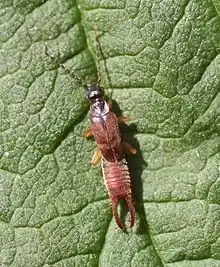Labia minor
Labia minor, the lesser earwig or small earwig, is a species of earwig. It is widespread globally in temperate climates, preferring warm locations such as compost heaps in parts of its range. It is 4–7 mm long, including the pincer, and chocolate brown in color.
| Labia minor | |
|---|---|
 | |
| Scientific classification | |
| Kingdom: | |
| Phylum: | |
| Class: | |
| Order: | |
| Family: | |
| Genus: | Labia |
| Species: | L. minor |
| Binomial name | |
| Labia minor | |
| Synonyms [1] | |
Description

Labia minor is about half the size of Forficula auricularia,[2] at 4–7 millimetres (0.2–0.3 in) long.[3] It is chocolate brown, and less shiny than the chestnut brown F. auricularia.[4] The whole body is covered with fine yellow setae, and the antennae are a paler color.[5] The forceps (pincer) at the animal's tail are used to help unfurl the wings, in preparation for flight.[3] Unlike F. auricularia, Labia minor flies frequently.[4][6]
Ecology
Labia minor feeds on decaying plant material and other detritus. In cooler climates, it is only found in warm places, such as actively decaying compost heaps, and are most often encountered when turning the compost.[4] Unusually for an insect, there is extensive maternal care of the eggs and offspring, with the mother feeding them for a week or two after they hatch.
Distribution
Labia minor is widespread in temperate zones around the world. It is unclear whether it is a native species in North America, or an early adventive species. The first record from the United States dates from 1838, but the species may have been present for a long time before that.[3] It ranges further north, into British Columbia and Quebec than any other earwig species,[3] and is the only earwig in Quebec.[1] It has also been introduced to Australia, Madeira, the Galápagos Islands and the Philippines.[1] The species is probably often overlooked, however, due to its small size, and may be more widespread than is currently known.[1]
Taxonomic history
Labia minor was originally named by Carl Linnaeus in the 10th edition of his work Systema Naturae in 1758, under the name Forficula minor.[3] When William Elford Leach established the genus Labia in 1815, Linnaeus' Forficula minor was made the type species of that new genus, and renamed Labia minor.[7]
References
- Robert L. Langston & J. A. Powell (1975). "The earwigs of California (Order Dermaptera)" (PDF). Bulletin of the California Insect Survey. 20: 1–25. ISBN 0-520-09524-3.
- Maurice Burton & Robert Burton (2002). "Earwig". International Wildlife Encyclopedia (3rd ed.). Marshall Cavendish. pp. 738–740. ISBN 978-0-7614-7266-7.
- "Species Labia minor – Lesser Earwig". BugGuide.net. Retrieved August 31, 2010.
- "Lesser earwig – Labia minor". Natural England. Archived from the original on January 6, 2010. Retrieved August 31, 2010.
- William H. Robinson (2005). "Collembola, Dermaptera". Handbook of urban insects and arachnids. Cambridge University Press. pp. 139–146. ISBN 978-0-521-81253-5.
- Judith A. Marshall (1999). "Dermaptera: the earwigs". In Peter Charles Barnard (ed.). Identifying British insects and arachnids: an annotated bibliography of key works. Cambridge University Press. pp. 40–41. ISBN 978-0-521-63241-6.
- Logan Hudson (1990). "A systematic review of the New Zealand Dermaptera". Journal of the Royal Society of New Zealand. 3 (2): 219 254.
